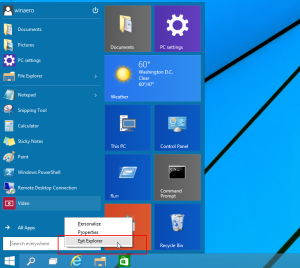Windows provides several secret ways to exit the Explorer shell. They can be useful when you make registry changes that affect Explorer or for shell developers when testing shell extensions. In case you didn’t know them, today I am going to share them with you.
Why you may want to restart Explorer
There are several reasons when you may want to exit the Explorer shell and start it again, such as:
- You are trying to uninstall some software with shell extensions, e.g. WinRAR. If you leave Explorer, all shell extensions will be unloaded from the shell and will be cleanly deleted by the uninstaller. All files that are locked for use by the Explorer.exe process will be released.
- If you applied some tweak which requires you to log off and log in back, in most cases, it is enough to only restart the shell.
Let’s see how this can be done.
Method 1: Use the secret “Exit Explorer” context menu item of Taskbar or Start Menu
On Windows 8, press and hold Ctrl+Shift keys on your keyboard and right click on an empty area of the Taskbar. Viola, you just got access to a hidden context menu item: “Exit Explorer”.
Windows 10 has a similar “Exit Explorer” option for the taskbar.

Additionally, it has the same command “Exit Explorer” in the context menu of the Start menu, as Windows 7 used to have:
- Open the Start menu in Windows 10.
- Press and hold Ctrl + Shift keys and right click the Start menu.
- The extra item will appear in the context menu, from there you can properly exit the Explorer shell:

In Windows 7 and Vista, you can hold down Ctrl+Shift and right click on an empty area of the Start Menu to access “Exit Explorer”.
To start Explorer again, press Ctrl+Shift+Esc to start the Task Manager, and use File -> New task menu item in Task Manager. Type Explorer in the “Create New Task” dialog and press Enter.
